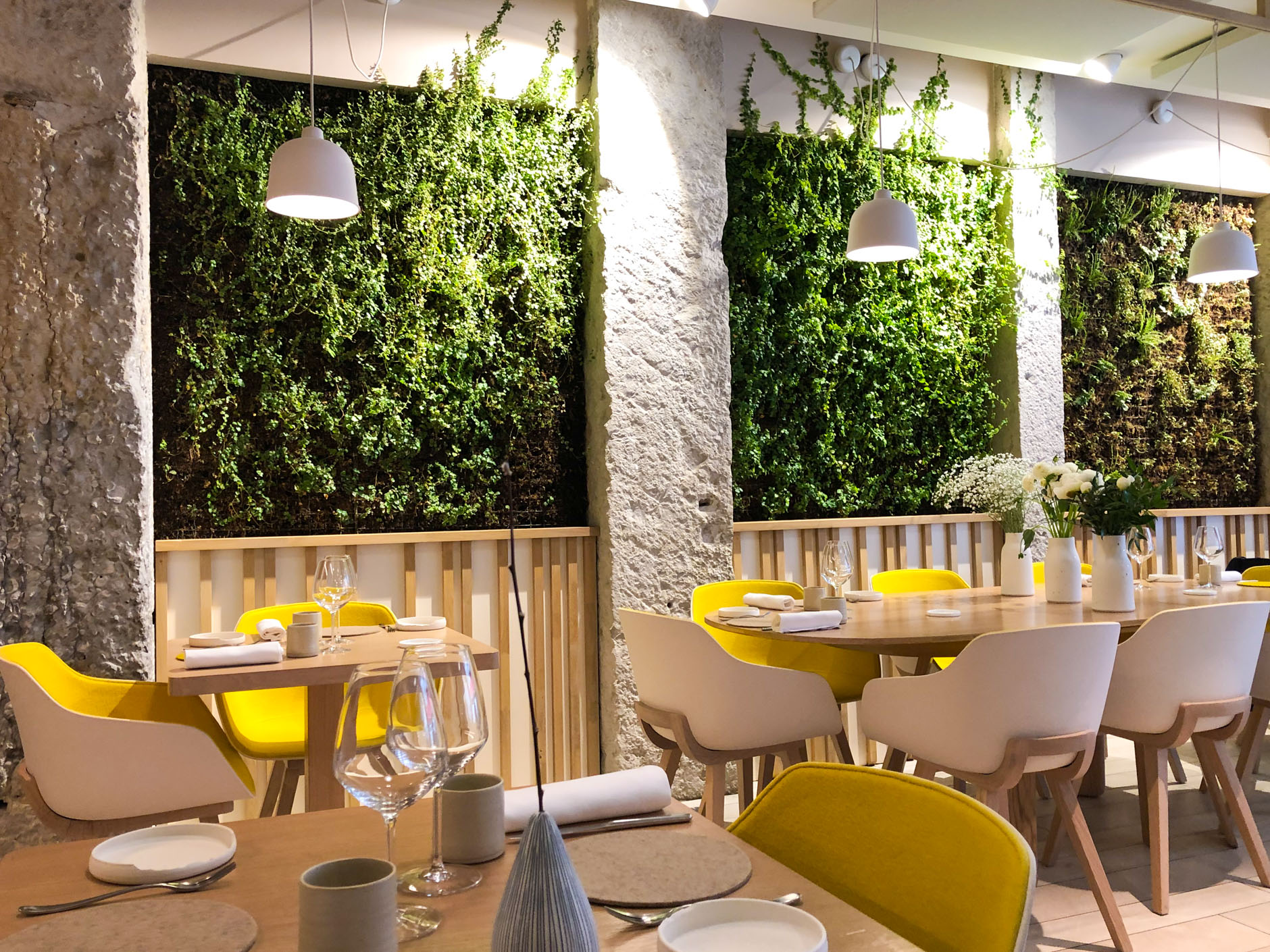Montmartre seems like an unlikely spot to play host to fabulous Greek cuisine. For me the quartier once evoked images of sleazy tourist traps and stodgy take-away crêpes. When I moved here, I loftily assumed that I would be fleeing to other arrondissements to dine — perhaps to the 11th, home to a gazillion natural wine bars, or to the Marais, where all the foodie cool cats still seem to congregate. Paris has an abundance of poor restaurants, not least in Montmartre. However, scratch the surface of the 18th arrondissement and you’ll be rewarded with some of the greatest eats in the city.
Enter Etsi — located in the funky Lamarck district and run by chef Mikaela Liaroutsos, who earned her stripes working with the likes of Cyril Lignac and Michel Rostang. Liaroutsos actually runs two restaurants (within 10 minutes walking distance of each other): Etsi le bistro and L’ouzeri. The former is a more formal version of the latter. Chatting with one of the waiters at Etsi, I learn that the food at L’ouzeri is heartier; the sort of fare one eats at home in Greece. A cursory Google and a glance at the (largely) glowing reviews suggest that L’ouzeri was opened as an overspill spot for all those wishing to eat in the bistro. And there’s no doubt that Etsi is popular: on my weeknight visit the phone is ringing off the hook, and a former Montmartre-dwelling pal informs me that one of her biggest regrets before moving across the river was not being able to bag a table there.
Despite the bistro’s popularity, none of the staff, including Liaroutsos (who pops in and out of the kitchen to chat to guests and run plates) has let its success go to their head. When I enter the restaurant, the atmosphere is friendly and welcoming. No one’s taking themselves too seriously, especially the bar staff who are encouraging guests to sample free shots of Tsipouro, an un-aged brandy not unlike Grappa. My friend and I hover in the stylish bar area, where the diners wait to be seated altogether in the adjoining salle. It’s quite compact (each of two evening sittings accounts for just under forty covers) and slightly chaotic; a cacophony of Greek, English and French. The room hushes when a waiter informs us that it’s time to sit down, and then rather grandly announces the menu for the whole restaurant to hear. Anticipation builds.
The exclusively Greek wine lists arrives, and I’ll admit to being slightly out of my depth, recognising only two. But no matter, for our charming waitress insists we sample them all. Although it’s well-documented that retsinas (wines made with the addition of pine resin) have undergone something of a renaissance in the last five years, I’m taken aback by their quality. One from the Tetramythos winery (Retsina Péloponnèse) I find particularly invigorating. We settle, however, on a bottle of Orgion, a dry red from the Lixouri region, which is pleasantly medium bodied and chocolatey. As our waitress regales us with a story about the chap who sourced the wine, Yiorgos — Paris’s ‘guy for Greek exports’ and so-called ambassador to the Greek mountains— we sink back and enjoy the convivial atmosphere.
Etsi is the only restaurant in Paris that I currently recommend to people without any anxiety that they’ll be disappointed
And so to the food. Etsi has an à la carte menu, comprising Greek/French inspired small plates designed for sharing, as well as a 39 euro tasting menu. I’m told that it’s possible to sub the final savoury plate for a dessert on the set menu, and we go ahead and order the ‘Faites confiance aux Grecs’ (Trust the Greeks). We start with Dakos, a sort of Greek bruschetta originating from Eastern Crete. The toppings apparently change every two to three weeks. Tonight’s was made with ripe avocado, coriander, peppery capers, yoghurt-like feta, cucumber and dill. The twice-baked barley bread soaks up all the vibrant juices; it’s one of the simplest yet tasty entrées I’ve had in a while. It might be drizzly in Paris, but as far as I’m concerned, I’m on the Med.
Three molten melitzanokeftedes (courgette beignets) are then served with homemade tzaziki. They’re piping hot with a crispy, almost caramelised, coating that reminds me of a good onion bhaji and a melt-in-your-mouth centre that’s punchy and moreish (a word I’ve never before used to describe courgette).
Next up is a roasted pumpkin dish served with hummus and paired with pine nuts and a red pepper tapenade. I’ve seen many iterations of this dish and I’m a bit worried that it will descend into what’s often a mushy bland afterthought. But we were right to trust in the Greeks: all the elements of the dish have been treated with care and attention, especially the veg — something at which both the French and the Greeks excel. The pumpkin is sweet and full of flavour; basted like a fine cut of meat, and the well-seasoned tangy hummus underneath cuts through its richness perfectly. The caramelised onions are a generous luxury, and the crunchy pine nuts help give the dish some texture. My friend and I fight over the last piece of pumpkin and hardly notice we’ve yet to be served meat or fish. The spanakopita (another veggie perennial that’s often dry and disappointing) arrives gorgeously, with black sesame seeds glistening in honey on the delightfully crisp top layer of filo.
When the fish and meat plates do arrive, we’re not disappointed. The pouple grille has been expertly handled — no rubbery over-cooking here. The outside is lightly charred, just hinting of barbeque and studded with pomegranate seeds and pistachios: it’s as much a pleasure to look at as to eat. We also demolish the confied echine de porc — brined overnight, it’s unctuous and tender and comes with a handful of well-roasted root vegetables. The final savoury dish arrives, (a crisp feta saganaki served with a type of mushroom ragu) and I think about the fabulous range of Greek cheeses we’ve been served this evening. Some dishes have been topped with tangy, harder varieties, while others have been scattered with soft and mild cheeses that use a higher percentage of goat’s milk; yet others have been prepared with nutty, smoky varieties. It certainly marks a difference from the run-of-the-mill Greek salads lazily topped with acrid feta that you see in many bistros here.
At this point in the meal, I’m fairly confident that Etsi can do no wrong. Plate after tasty plate has arrived (nine to be exact, which at 39 euros per person makes for a more than reasonable deal) each as full of flair and attention to detail as the next. The kitchen balances brilliantly the bold and the refined; dishes have felt comforting but they’ve all been elevated too, with simple touches — a squeeze of lemon here, a whiff of dill there. The dessert arrives and though it doesn’t knock me off my seat, I’m not sure I need it to. The tarte au citron à la Masticha (a type of Greek lemonade) is sherbety, light and cleanses the palate perfectly. I’ve eaten a generous tasting menu, but I polish it off feeling like a Greek goddess (and I promise that’s not just the shot of Tsipouro talking!).
Since eating at Etsi I’ve thought about it a lot which can only be a good sign. While it’s certainly a paradise for veggies, the quality of its whole menu makes it worth seeking out. It’s the only restaurant in Paris that I currently recommend to people without any anxiety that they’ll be disappointed. Faites confiance aux Grecs!
23 rue Eugène Carrière
75018 Paris
France
May 2023









